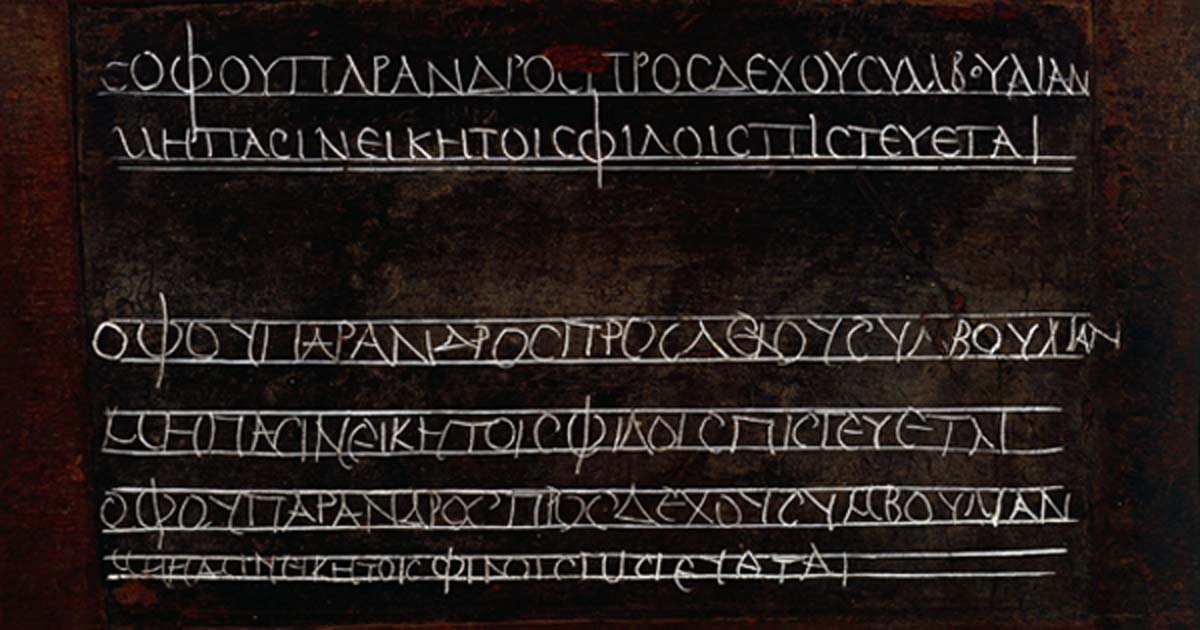Egyptian Child’s Greek Homework from 1,800 Years Ago Goes on Display
An ancient wax tablet has recently surfaced, shedding light on the educational practices of children from almost two millennia ago. This remarkable artifact, which serves as a testament to the past, features a collection of spelling exercises, times tables, and handwriting samples, all carefully etched into its surface. This unique glimpse into the methods of teaching employed for ancient youths remained concealed within storage for an astonishing four decades. However, it is now set to take center stage at the British Library as part of the captivating interactive exhibition "Writing: Making Your Mark," scheduled to run from April 26 to August 27, 2019.
As reported by The Daily Mail, Roly Keating, the esteemed chief executive of the British Library, marveled at this discovery. He remarked that "the homework market is a treasure trove of historical insights," showcasing two lines of Greek meticulously carved into the wax by a child believed to be eight or nine years old. Keating further emphasized the significance of this find, stating, "This is a glimpse into the homework of a primary school student living in second-century AD Egypt, preserved on this diminutive tablet, roughly akin in size to an iPad mini."
The word ‘tablet’ is somewhat confusing, even when prefixed with the word ‘wax’. To some readers ‘tablet’ it is a deliciously sweet melt in the mouth fudge, while to others it’s a bedtime reading device, and many more only talk about a ‘tablet’ when they have a headache or need relief from an infection.
However, in its archaeological context, an entry in the Library of the University of Michigan informs that “wax tablets” were “unique among ancient writing materials” because they could easily be erased and reused. They were formed by depositing a thin layer of wax on a flat piece of wood with raised edges.” And, so far as executing the letters was concerned, a device called a “stylus” was shaped like a pencil with a pointed end for writing and a flat end for scraping the wax to obliterate mistakes.

A wax tablet and stylus from the Roman period (CC by SA)
What Did the Child Write About?
Among the contents of the ancient wax tablet the child wrote out the words of a quote which says: “You should accept advice only from a wise man.” But what is remarkable about the child’s writing is their attention to detail, especially in the alignment of the letters and words. They used a ruler to establish near perfect horizontal alignment and to assure all their letters were of similar height.
Other writing media used by the ancient Greeks included inks on papyrus and carving on rocks. A 2011 report in National Geographic tells how archaeologists excavating in an olive grove in the modern village of Ikkaina discovered an ancient tablet created by “a Greek-speaking Mycenaean scribe between 1450 and 1350 BC.” The archaeologists claim that ‘writing’ would have been considered "magical or mysterious" in that time, and this example only survives “because a trash heap caught fire some 3,500 years ago.”
- Child Doodles Discovered in 14th Century Manuscript
- Caves in Paradise: The Elite School of Aristotle
- Walls of ancient Egyptian school etched with words of encouragement for the students

A child showing a woman (Greek, c. 100 BC) a wax writing tablet (CC by SA 2.0)
Writing: Making Your Mark Exhibition
More than 100 objects from the British Library’s collection will be on display, which their website claims “bridges 5,000 years” and “spans five continents.” The exhibit begins with Egyptian hieroglyphs carved on a stone monument and early examples of printed texts such as the Mainz Psalter, right through to the ground-breaking digital communication tools we use today.” Among the ancient innovations being displayed are: a Chinese typewriter, James Joyce’s annotated copy of Ulysses, a 60,000 strong petition against Bengali partition, tattooing instruments, extracts from Leonardo da Vinci's notebooks, a printing of Chaucer's Canterbury Tales from 1470.
One thing that needs fixing in all this, however, is that the British Museum are calling their exhibition “interactive.” This word only really only applies to the folk lucky enough to be in London in April. However, you can make all this very interactive, by spending a winters afternoon making an ancient Greek wax tablet with your children. Where would you even start?
Dr. Karen Carr is Associate Professor Emerita, Department of History, Portland State University. On the website QUATR.us, she offers a really safe, step-by-step guide which promises great family fun. But on a more serious note, parents should never ever underestimate the real-life importance of doing such crafts with their children. While it is very convenient to pop an electronic tablet in a child’s hands, it is in the fineries of making tricky things, ‘especially learning to write’, that children develop the fine motor skills and dexterity required for brain and eye surgery, watchmaking and chemical engineering.
Top image: Wax diptycha or tablet, forming a schoolboy's Greek exercise book. The tablet contains two lines, written neatly above as a model and then copied twice betwen the ruled lines; the first line, and possibly the second, are from the poet Menander. (British Library / flickr)
By Ashley Cowie




















Comments
article was very lacking in for one how a wax tablet survived a fire 3500 years ago. . and how any of it relaxes to anything they wrote about.
jolly r hansen
I found this story fascinating. Wondering who the child's parents would have been. Were all children privy to education? Or, just upper class? I'm very much a novice and new to Ancient Origins... and trying to put 1800 years ago in perspective. Thank you for the article.